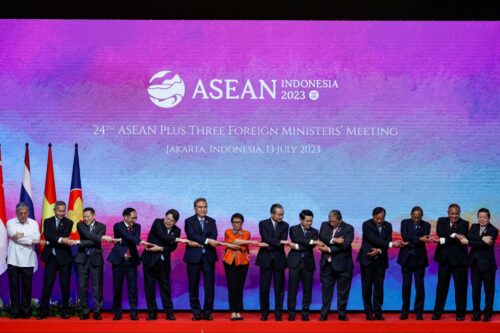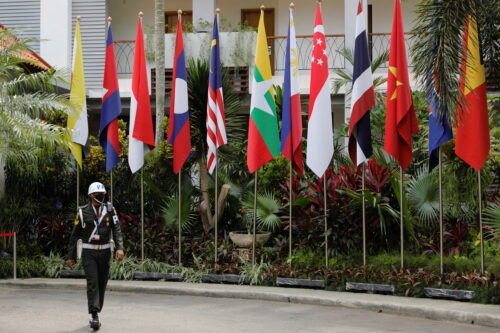In the China-Laos Railway, Beijing reveals its designs for Southeast Asia
As the first leg of an envisioned Chinese-built network connecting Kunming, Yangon, Hanoi, Phnom Penh, Bangkok, and Singapore, the China-Laos rail moves a Chinese-led Southeast Asian order one step closer to reality.

On December 3, a train rolled into Vientiane, the capital of Laos, on a journey that might have been like any other — had it not set off from Kunming, the capital of China’s Yunnan province, on the first day of operations of the China-Laos Railway. A project five years in the making fraught with debt and delay, the railway has inaugurated a new era of Chinese power in Southeast Asia, one marked by frenetic Chinese diplomacy and the entrenchment of Chinese technical standards there, but possibly defined by a grander vision of a region fully connected by rail. The China-Laos railway is only the first leg of an envisioned railway line that would snake down from Kunming to Singapore, crisscrossing the mainland’s largest cities in the process.
Plans to connect the region by rail were first articulated in the late 19th and early 20th centuries, but French colonists lacked the technology and Japanese occupiers lacked the time to make it a reality. China, in the 21st century, has the former in abundance and the latter on its side.
China-ASEAN
Southeast Asia is China’s rapidly developing, 650-million-person-strong neighbor — and a newly opened front in its rivalry with the United States. In 2021, China treated it as such, cajoling and coaxing the region’s leaders. In June, ASEAN’s foreign ministers, including its Secretary-General, met with Chinese foreign minister Wáng Yì 王毅 in Chongqing to mark the 30th anniversary of China-ASEAN relations. That relationship has kept Wang Yi busy — bearing gifts, he visited nearly every Southeast Asian capital last year. On a September visit to Cambodia, he promised the country $272 million in grant aid. The attention he’s paid the region compares particularly well with the dismal record of his counterpart, U.S. Secretary of State Antony Blinken, who kept ASEAN foreign ministers waiting for their first meeting in May, then missed it due to a technical error.
Wang Yi’s journeys across the region highlight the newfound importance China places on its relationship with ASEAN. At a November summit, China upgraded its relationship with the bloc to a “comprehensive strategic partnership,” a largely symbolic gesture but one that puts it on the same diplomatic footing as the European Union. Xí Jìnpíng 习近平 announced a flurry of new initiatives directed at the region, including a promise to provide $1.5 billion in development assistance to combat the pandemic, support for a new exchange program inviting 300 Southeast Asian scientists to China, and a commitment to deepen the China-ASEAN Free Trade Area. Emphasizing the shared “eastern” culture of China and Southeast Asia, he personally exhorted the region’s leaders to “work hand in hand” with China.
China news, weekly.
Sign up for The China Project’s weekly newsletter, our free roundup of the most important China stories.
The battle over technical standards
Southeast Asia is also at the front lines of China’s quiet war on Western-dominated global technical standards. The China-Laos Railway is one of the first international railways in the world to exclusively use Chinese technical standards. Beijing is moving quickly in ASEAN — still underdeveloped and badly in need of infrastructure — in order to lock in its standards, entrenching its economic advantage there and pushing its standards closer to worldwide acceptance.
Southeast Asia, having proved one domino theory wrong, may prove another right: if Laos’s ASEAN partners want to connect with it by rail, they are now likely to opt for Chinese standards, tipping the scales of the region in favor of future transportation purchases from China. As the owner of the standard, Beijing stands to reap decades-long benefits far beyond the immediate profits to be made from the railway. China’s “going out” with its standards has seen victories further afield as well. The Chinese-funded Budapest-Belgrade rail line, still under construction, has already marked the first connection of Chinese railway standards to European standards.
Warring over the narrative
China also sees Southeast Asia as a place to juxtapose the central narrative of its presence abroad with the United States’s legacy of global dominance: while America bombs, China builds. Chinese journalists were quick to circulate an image comparing the U.S.’s bombing campaign of Laos during the Vietnam War with China’s construction of the railway in the aftermath of its opening.
The railway also pokes another hole in the now-debunked “debt trap” myth, which says China seeks to saddle Belt and Road partners with unsustainable debt, causing projects to fail and allowing Beijing to scoop up the leftover assets. Contrary to the popular image of clueless host countries helpless to resist Chinese investment offers, Laotian ministers took a conscious, calculated risk in accepting the project. As a senior Lao official explained to scholar David Lampton in 2017, “[If we don’t accept], we won’t have any debt. But then we will [continue to] be poor like this.” Aware of the risks, Laos defies the misconceived image of China as a loan shark and the Belt and Road as a predatory lending scheme.
The future of the region
But all of this pales in comparison to the promise the railway holds for the future. As only the first leg of an envisioned Chinese-built network connecting Kunming, Yangon, Hanoi, Phnom Penh, Bangkok, and Singapore, it moves a Chinese-led Southeast Asian order one step closer to reality. That order would have the region default to Chinese technical standards and e-payment apps, look sooner north than west for crisis resolution in the region, and catapult China up the value chain by providing easy access to the region’s increasingly cheap manufacturing. The railway would be at the center of it all, establishing Kunming as the beating economic heart of the region, connected to the sea by China’s new maritime trade and investment partnerships with ASEAN members.
Through a sudden coup and earthshaking election, China has continued to press for the railway’s construction. Three months before the completion of the Kunming-Vientiane line, the last line of rail was laid to connect Chengdu to Lincang, a Chinese city on the country’s border with Myanmar, a critical first step in eventually linking the rail with Yangon. The Bangkok-Nong Khai line, which would link up with Vientiane and Kunming, took another step forward at the end of December when China and Thailand agreed upon designs for its second phase. Completion, which is expected in 2028, would see Thailand’s first high-speed rail line operated by China for the first three years of its existence.
The vision for a Southeast Asia fully connected by rail has run into its greatest obstacle in Malaysia. In the aftermath of the election of China-skeptic Mahathir Mohamad, Malaysia came to an agreement with Singapore at the beginning of 2020 to cancel the line that would connect Kuala Lumpur to Singapore. But China is playing the long game. As a Thai businessman explained to Lampton, “Rail projects take time. It is like growing trees: if you want trees, you plant trees, and then wait for thirty to forty years. China is a communist country; they can wait. They are planting trees now.” What attracted Laos may eventually seduce even the most wary of Southeast Asian countries: the fear of being left out. The immediate success of the Kunming-Vientiane line may be even more convincing. The line is expected to spirit away one million Chinese passengers two months after opening for China’s lunar new year.
Southeast Asia, at the center of the Indo-Pacific, is of critical importance to the future of Chinese power. That has not been lost on China, which looks hungrily south upon a fast-growing economy and shared cultural environment where it has first-mover advantage. There, it is steadily laying the tracks of a new regional order.






